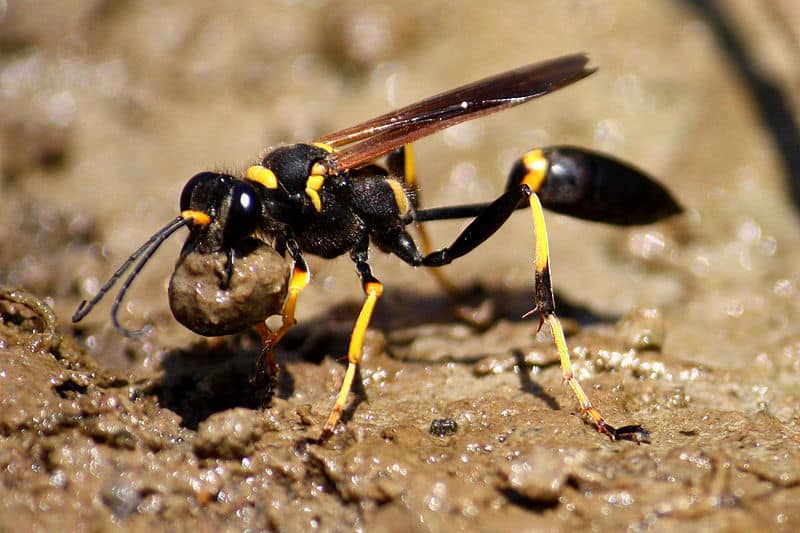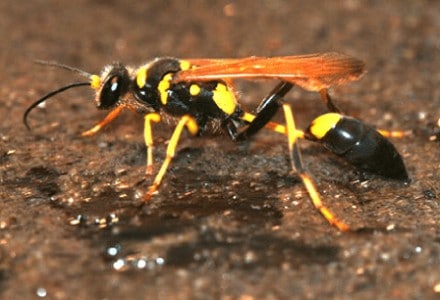
Black and Yellow Mud Dauber Facts
- Most notably, the admittedly somewhat lengthy term Black and Yellow Mud Dauber aptly serves its purpose. That’s because it serves as the common name for a highly specific species of wasp.
- At present, entomologists recognize a total of 30 related species throughout the world. While differences naturally occur, in many ways all of them have many characteristics in common.
- The common name derives from the simple fact that it typically constructs its small nest out of the mud. The Black and Yellow Mud Dauber also generally nests in areas that appear to it to be relatively sheltered.
- Further, these often include such man-made locations as barns, bridges, and commonly the eaves of many houses. But, as with most known varieties of wasp, this fascinating insect also lives as a highly solitary creature.
- Finally, unlike many species, its numbers appear to be sufficient and stable for the moment. As a result, the IUCN does not have a listing of this particular invertebrate.
Related Articles
Jewel Wasp Bald-Faced Hornet Cuckoo Wasp
Photographer: Ryan Hodnett
CC License: https://bit.ly/1xMszCg
Black and Yellow Mud Dauber Physical Description
Firstly, the Black and Yellow Mud Dauber possesses an extremely elongated physical form. However, it typically attains a relatively common size, for its kind. As a result, it usually averages a length of roughly 1.2 in (30 mm).
Further, as indicated by the rather descriptive name, its coloring has a very specific pattern. This remains quite distinctive. It therefore appears as a combination of a black body, with bright yellow stripes across it.
In addition, the eyes and antennae also present a deep black in color. Yet, in stark contrast to this, the legs mainly display a brilliant yellow. But, the top, middle, and bottom portions of the legs present black as well.
- Kingdom: Animalia
- Phylum: Arthropoda
- Class: Insecta
- Order: Hymenoptera
- Family: Sphecidae
- Genus: Sceliphron
- Species: S. caementarium
Black and Yellow Mud Dauber Distribution, Habitat, and Ecology
First of all, the gorgeous Black and Yellow Mud Dauber developed endemically in North America and Central America. However, due to international commerce, it has become established in a many parts of the world.
But, the greater part of its numbers inhabit regions in both the United States and Canada. Nevertheless, within that range the arthropod has preferred habitats. These primarily include rocky ledges, certain trees, and even man-made structures.
While it will obviously defend its nests, the wasp rarely seems overtly aggressive by nature. Stings by this insect happen rarely, and the effects of such occurrences typically stay quite mild.
Further, this species preys exclusively on a moderate variety of spiders. Several species often serve as prey, but Orb weavers remain the most commonly hunted.
These the female returns to the nest, to serve as food for her offspring, once they have hatched into larvae. Finally, the female Black and Yellow Mud Dauber commonly leaves the nest at night, to rest on nearby vegetation.
Species Sharing Its Range
Cougar Carolina Silverbell Rosy Maple Moth
Check out our other articles on Earth’s Geothermal Marvels, Orca, Thorny Dragon, Fingal’s Cave, Striped Pyjama Squid, Red Panda, Guatemalan Fir, Vietnamese Mossy Frog

